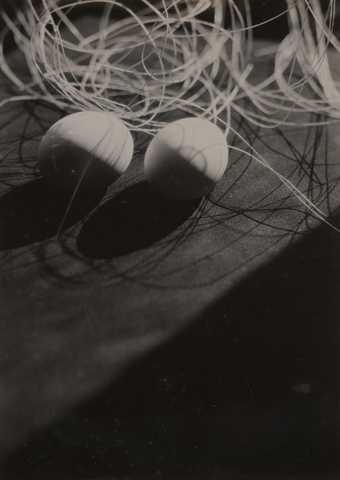
Iwao Yamawaki
Untitled (Interior, Bauhaus, Dessau)
(1930–2)
Tate

Iwao Yamawaki
Untitled (Composition with eggs and string, Bauhaus)
(1930–2)
Tate
Introduction to the New Vision
Following the first mechanized conflict of the First World War, artists began to reclaim the mechanisms of image-making in the contemporary industrialised world. The 1920s and 1930s was an experiemental time for photography, where unconventional techniques such as abstract photograms, photomontages and combinations of photography and graphic design suddenly flourished.
With close ties to the Bauhaus (in particular the work of Laszlo Moholy-Nagy) The New Vision aimed to look at the world through the camera lens, using it as a mirror to the reality of the everyday, and also a framing device for the documentary and experimental.
Photography soon took hold as a viable alternative to the painting of the early twentieth century. Iwao Yamawaki, a student at the Bauhaus School, incorporated the structural lines of modernist architecture, strong effects of light and shadow, and close-ups that zoom in on a single texture or repeated motif.
Further reading
The Modern Lens: How the Bauhaus school influenced international photography
This article looks at how teachings of the Bauhaus school including Moholy-Nagy andWalter Peterhansinfluenced modernist photographers around the world.
Albers and Moholy-Nagy: from the Bauhaus to the New World
Read the room guide to this Tate Modern exhibition which was on display in 2006. Rooms three and four focus on Bauhaus and photography.
Klee’s fourth rule of Bauhaus: find your perspective
This article looks at how Paul klee played with the rules of perspective and how that inspired this new look at photography.
Nature, buildings and people
This Tate Etc. article looks at the work of Harry Callahan who became an important teaching figure in the New Vision movement and the development of post-war American photography.
